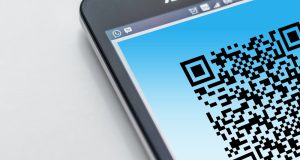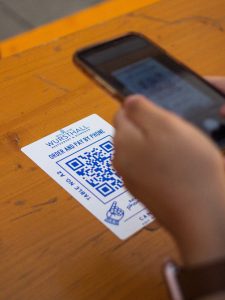Consumer restaurant relations have shifted dramatically over the past year. Customers were already beginning to use the digital sphere more frequently to inform their dining, and COVID-19 increased this usage as customers turned to smartphones to view online menus as well as to keep informed of what restaurants and bars were doing, safety practices they were implementing, or payment methods they were using.
The State of the Restaurant Industry report from the National Restaurant Association shows that tech adoption accelerated due to the pandemic as contactless and mobile payment options became crucial.
Smartphones will continue to play a pivotal role in connecting restaurants to their customers, and QR codes serve as an important link in this process. QR codes make an easy bridge to the digital world—giving instant access to any number of websites or landing pages with a quick scan of a phone.
QR codes allow for easier contactless interaction, but they have uses far beyond linking to online menus. Now that consumers have adopted and grown comfortable using them, restaurants and bars can find ways to incorporate this tool more deeply into their marketing and operations to bring greater levels of engagement between the customer and business.
Below is a list of four ways bars and restaurants can do more with QR codes to be effective in both reaching and keeping customers.
1. Link to Landing Pages
Linking a QR code to an online menu is helpful, but a landing page opens up a whole other world of possibilities.
A landing page can display important links in one, easy-to-access spot. It streamlines the process of finding key pages or updates, and is a great option for mobile viewing. A landing page is not only useful, it looks more organized and has more to offer in a single click. This saves the customer time they might otherwise need to take to search for these pages (or the time they won’t take).
A landing page not only allows customers to carry out multiple actions quickly, it can lead to a greater chance of them checking out more about the business with all the links hosted in one place. Plus, the ease of use and professional look of a landing page further cements your brand!
Here are some ideas of the types of links landing pages can feature:
- Main menus
- Specialty or holiday menus
- Mobile business cards
- Social media channels
- Online ordering systems
- Websites
- PDFs
- News or recent updates
- Feedback forms
Many types of businesses and industries have begun using landing pages with greater frequency, and with customers often turning to their phone and social media channels for information, this tool saves time and engages customers more deeply so they’re more likely to come back in the future.
2. Tracking Usage
Some QR codes have the benefit of providing usage data so restaurants can better understand what types of content is reaching and engaging their customers. These data analyses can in turn help direct marketing efforts.

For example, the number of scans a single QR code has generated allows restaurant owners to determine how engaging their marketing tool is or how interested the customer is in the particular product being offered (eg: how likely is someone to scan the flyer linking to a holiday specials menu). Knowing how many scans per device exist shows the number of individuals the content is reaching. Scans over time would show by week, month, or year when people are most likely to scan a particular code. This can direct restaurants on the timing of marketing seasonal menu items or products.
These are just a few of the data points QR codes can illustrate, but the bottom line is that this data can help restaurants to understand better what customers are looking for and when, which saves time and energy.
3. Collecting Data
A QR code can help restaurant owners gather data by linking to online forms that collect information like email addresses and phone numbers. Leaving a table tent with a QR code by the checkout counter, or putting a note in with a takeout order, could be good spots for informing customers of how they can receive updates, offers, and newsletters from the business.
Though this kind of communication is often used for featuring discounts or specials, it doesn’t need to be solely promotional. Including neighborhood events, collaborations, or recipe ideas are great ways to connect more deeply with the local community, which will build relationships in the long-term.
4. Upgrading Traditional Marketing
Flyers, sandwich boards, stickers, table tents—as we’ve seen in 2020, all of these tools can double their effectiveness if a QR code is added to them. However, taking into consideration how to best utilize a QR code on one of these marketing tools can be just as important as having one.
Since a QR code links to further information, it inherently allows for the product to have less writing on it. Keep messaging short and simple so it’s easy to read and the QR code is what’s prominently visible. This adds to its likelihood of being scanned, plus customers will be curious about where the QR code leads.
There are many useful pages to link with your QR code and much of that decision will depend on the goal of the marketing tool you’re using and where it is physically located in the business or elsewhere. Some ideas of where to link:
- Main menus
- Specialty or holiday menus
- Websites
- Landing pages
- Online ordering systems
- Social media channels
- Videos
- Review sites or pages
- Event pages
- Coupons
- Customer information forms
Looking Forward
QR codes are already being used for many purposes at restaurants and bars, and finding ways to further implement QR codes into daily processes will take restaurant marketing to the next level.








